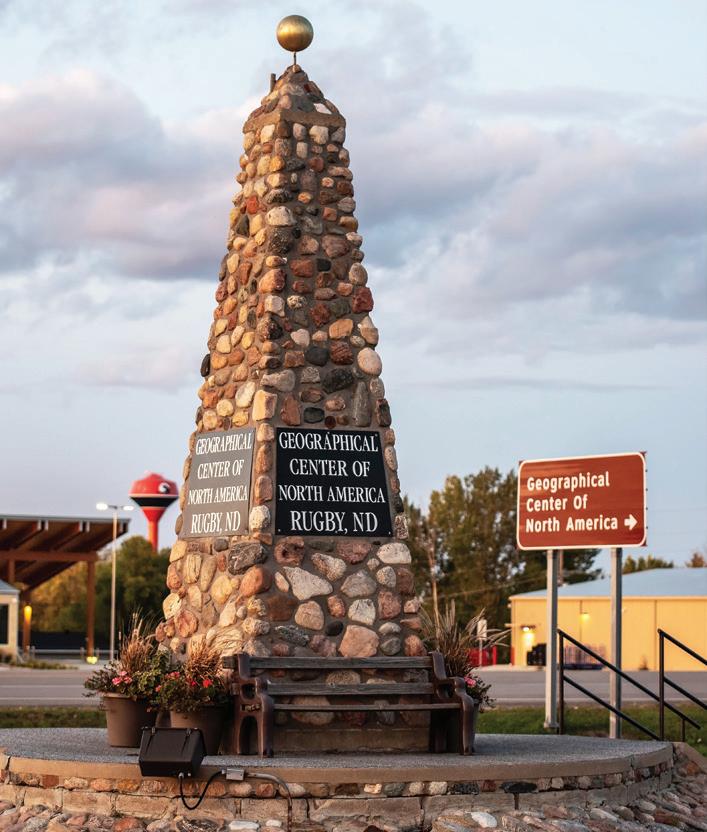
3 minute read
What’s In A Name: Rugby and
Rugby and Surrey, N.D.
By Ray Balogh | The Municipal
A string of municipalities in North Dakota, all situated along a transcontinental route of the Great Northern Railway, was dubbed by the railroad after locations in England. The towns included
Winter settles in on Surrey, N.D., a quiet community that has also been one of the fastest growing small towns in America for the past three decades. (Photo provided by Surrey, N.D.) Though modern measurements place the geographic center of North America nearly 150 miles away from Rugby, the town still proudly proclaims its designation on a 21-foot obelisk erected in 1932. (Shutterstock.com)
Surrey
Surrey was founded on June 18, 1900, by Great Northern Railway officials and was officially incorporated in 1951.
In 1910, Surrey gained popularity as being the starting point for construction to shorten the Great Northern transcontinental route. Completed in 1912, the new 44-mile shortcut, which came to be known as Surrey Cutoff, enhanced business for the town. The cutoff and the original line are still in place today, with the cutoff still used as part of the Burlington Northern Santa Fe (BNSF) Railway’s northernmost transcontinental route.
Surrey is located 7 miles east of Minot, and its small-town and family-friendly atmosphere make the municipality of 1,415 residents an ideal bedroom community for those commuting to Minot (population 47,236), most of them to work at Minot Air Force Base, which employs 5,470 military personnel and 722 civilian employees.
Surrey’s population, with occasional pauses of stagnation, has grown steadily since 1990, and has grown faster than 93% of similarly sized cities in the last 20 years. The town’s amenities include multiple parks with playgrounds, a ball complex, walking path, RV park, Lutheran church, senior activity center and various small businesses.
Planners and developers have labored to accommodate newcomers. Silver Springs is a new 667-acre master planned community seven minutes from the center of town. The development consists of 14 unique subcommunities, parks and pet-friendly walking trails.
For more information, visit www.surreynd.org.
Berwick, Leeds, Knox, Norwich, Penn, Churchs Ferry, Tunbridge and York. Among that number are Surrey and Rugby, both named after their respective counterpart towns in Warwickshire, England.

Rugby
Rugby (population 2,470) was founded in 1886 as Rugby Junction, where a branch line of the Great Northern Railway met the main line of the transcontinental railroad. When the settlement became a city, it dropped “Junction” from its name.
Its first permanent settlers arrived in 1812, bringing with them advanced farming methods and machinery, including an early McCormick Deering threshing machine, now housed in a Rugby museum in the restored Pioneer Village.
Rugby has long billed itself as the geographic center of North America, a claim confirmed by geographical measurement in effect at the time. In 1932, the town erected a 21-foot rock obelisk marking the exact center of the continent. The monument was moved a short distance in 1971 to accommodate the expansion of U.S. Highway 2. The monument features flags of the United States, Canada and Mexico.
Recent refinements in measurements, however, have cast credible doubt on Rugby’s claim, and it appears the true center is 145 miles to the southwest, located in the appropriately named town of Center, N.D.
Dwarfing the obelisk is the nearby Northern Lights Tower, an 88-foot edifice of steel pillars lit to mimic the effect of the aurora borealis. Another notable historic attraction is the Victorian Dress Museum, located in a former church building listed on the National Register of Historic Places.
The Prairie Village and Museum complex contains 23 historic buildings and exhibition halls offering an exhaustive curriculum of local and regional history and culture.
For more information, visit www.cityofrugbynd.com.










